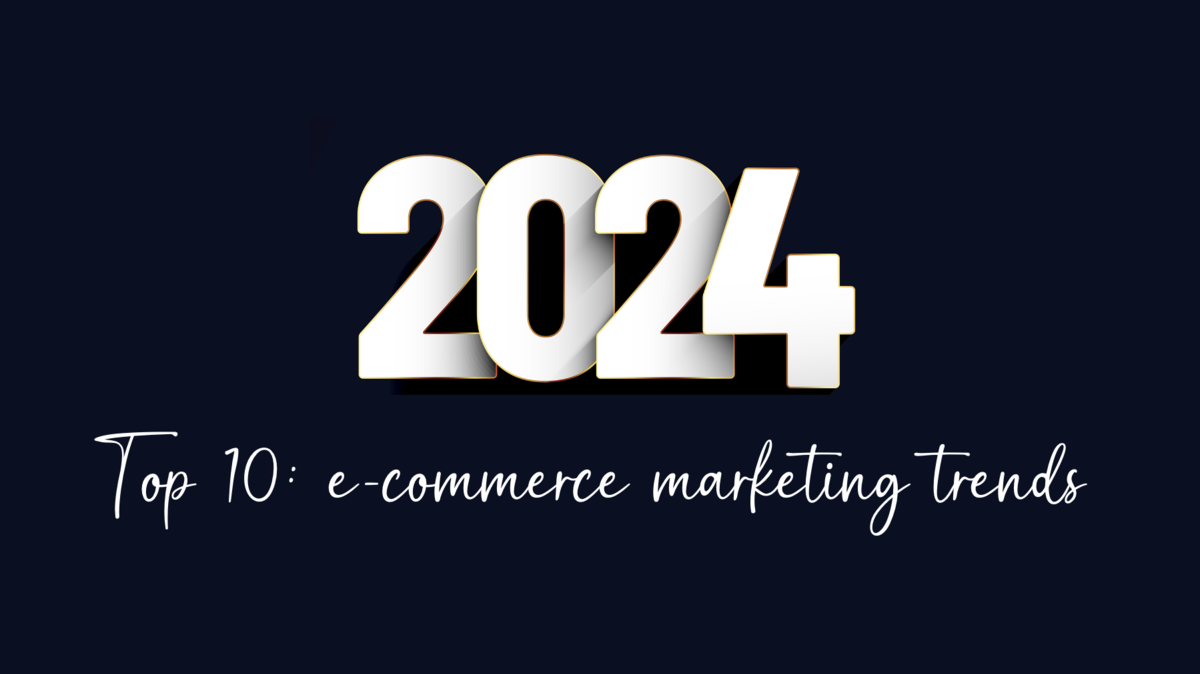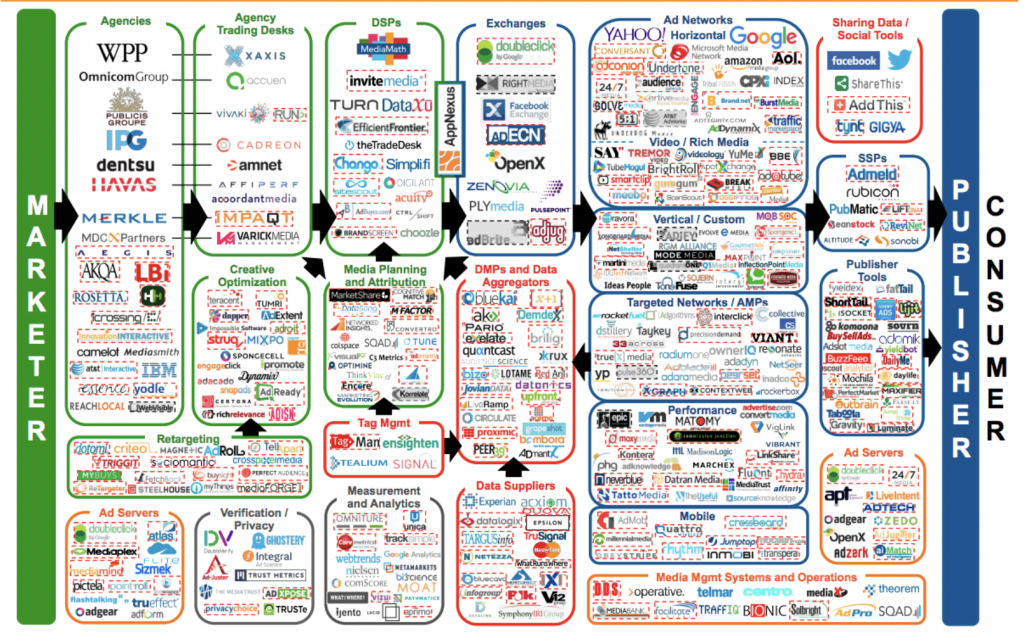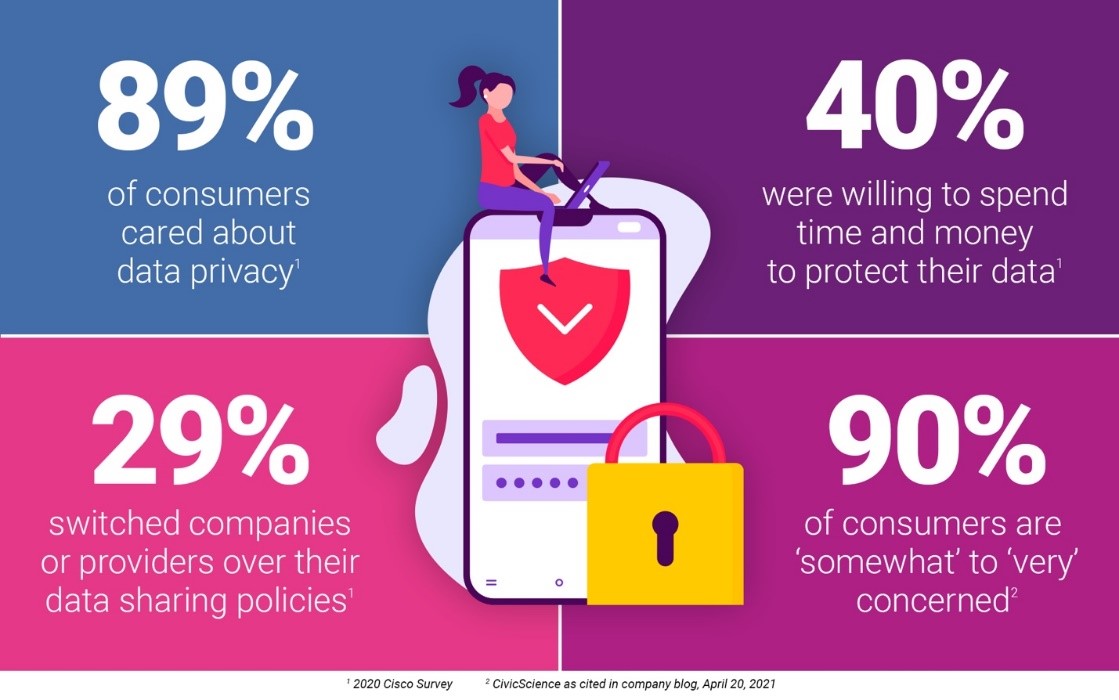blog»Digital Marketing»The Next Wave of E-Commerce: 10 Marketing Trends to Watch in 2024

The Next Wave of E-Commerce: 10 Marketing Trends to Watch in 2024
2023/12/04
You can read this article in about 49 minutes
Introduction
As we ride the crest of another year in the ever-evolving world of e-commerce, it’s time to take a moment and reflect – not just on the whirlwind that was 2023, but also on the horizon ahead. In an industry that’s as dynamic as e-commerce, looking back is just as crucial as looking forward. Why, you ask? Because every year brings its own set of lessons, challenges, and breakthroughs that shape the future of how we market, sell, and engage with our ever-discerning customers.
Remember when personalized email campaigns felt like the cutting edge? Or when the idea of shopping via a social media app was just a glimmer in a marketer’s eye? Ah, those were the days. But here in the world of 2024, the e-commerce landscape is not just about riding the wave – it’s about being the wave.
As we stand at the brink of 2024, it’s clear that the lessons from the past years have culminated into a new era of e-commerce. An era that’s driven by technology, defined by creativity, and dictated by consumer preferences that are as fluid as they are unpredictable.
So, what’s in store for us this year? Think AI-generated content that’s so on point, it’s almost like having a mind-reading assistant. Picture a world where sustainable products aren’t just a niche market but a major player. And let’s not forget the sophisticated ad strategies that are becoming increasingly crucial in the intricate dance of digital retail.
This article, “The Next Wave of E-Commerce: 10 Marketing Trends to Watch in 2024,” is your compass to navigate these exciting yet challenging waters. We’re not just talking about predictions here; we’re talking about a roadmap crafted from the trends that are already shaping the way we do business.
As we delve into these trends, we’ll see how they’re not just standalone concepts but interconnected elements of a larger, more complex e-commerce ecosystem. From AI’s transformative power to the green revolution in product choices, and the ever-evolving art of digital advertising – each trend is a piece of the puzzle that makes up the vibrant picture of e-commerce in 2024.
So, grab your surfboard (or just a comfortable chair), and let’s dive into the future of e-commerce. Whether you’re a seasoned marketer or a newcomer to the digital marketplace, these insights are tailored to help you stay ahead of the curve and make 2024 a year of groundbreaking success. After all, in the world of e-commerce, the only constant is change, and the best way to predict the future is to create it.
Trend 1: AI-Generated Content for Dynamic Marketing
As we step into 2024, the e-commerce landscape is witnessing a paradigm shift, with AI-generated content leading the charge. This isn’t just about automation or efficiency; it’s about revolutionizing how brands communicate, engage, and connect with their audiences. In a world where content is king, AI is the power behind the throne, bringing a level of personalization and creativity that was once unthinkable.
The Rise of AI in Content Creation
Gone are the days when personalized content was limited to inserting a customer’s name in an email. Today, AI is crafting content that resonates on a personal level, tapping into the nuanced preferences and behaviors of individual consumers. This includes everything from AI-generated images and videos to personalized narratives that speak directly to the consumer’s needs and desires.
The beauty of AI in content creation lies in its ability to analyze vast amounts of data and learn from it. This means it can continuously improve its output, ensuring that the content not only attracts attention but also retains it. Whether it’s through targeted blog posts, product descriptions, or interactive videos, AI is transforming the way brands tell their stories.
Enhancing Customer Engagement and Brand Storytelling
AI-generated content isn’t just about efficiency; it’s about creating deeper, more meaningful connections. It enables brands to craft stories that are not only relevant but also incredibly engaging. Imagine a world where a promotional video is not just a general ad, but a personalized narrative that reflects the viewer’s own experiences or interests. This level of customization makes the customer feel understood and valued, leading to stronger brand loyalty and engagement.
Powerful AI Tools in the Market
As we delve into the realm of AI tools revolutionizing content creation, it’s worth highlighting some key players alongside ChatGPT. ChatGPT has been pivotal in generating human-like text, from crafting engaging product descriptions to providing customer service responses that truly resonate with the audience.

But the AI toolbox doesn’t end there. For instance, tools like DALL-E and DeepArt have transformed the way we create visual content. DALL-E specializes in generating unique, high-quality images from textual descriptions, offering a new horizon in customized visual storytelling. Whether it’s for creating product images or marketing materials, DALL-E provides a glimpse into a future where creative possibilities are endless.
In the realm of video, platforms like Synthesia are making waves. Synthesia allows for the creation of AI-generated videos, complete with virtual avatars and synthesized speech. This means companies can produce high-quality video content without the need for extensive resources like video shoots and actors. It’s perfect for creating everything from product demos to training videos, all tailored to the viewer’s preferences and interests.
These tools represent just the tip of the AI iceberg. They are not just about creating content; they’re about crafting experiences that resonate with audiences on a deeply personal level. As these technologies continue to evolve and become more accessible, the landscape of e-commerce marketing will undoubtedly transform, offering unprecedented ways to connect with and captivate customers.
Conclusion
In 2024, AI-generated content is not just a trend; it’s a cornerstone of dynamic marketing in the e-commerce industry. It offers a level of personalization and engagement that was once only a marketer’s dream. As we continue to harness the power of AI, the potential for brand storytelling and customer connection is limitless. The future of content is here, and it’s powered by AI.
Trend 2: The Surge of Green Consumerism
In 2024, a significant shift in consumer preferences has ushered in the era of green consumerism. This isn’t a fleeting trend but a fundamental change in the ethos of the buying public. Consumers are increasingly seeking out brands that align with their values of sustainability and environmental responsibility, making green consumerism a critical focus for e-commerce marketers.
Demand for Sustainable and Eco-Friendly Products
Today’s consumers are more informed and concerned about the environmental impact of their purchases than ever before. They’re not just looking for quality products; they want assurances that these products are made sustainably and ethically. This surge in demand for eco-friendly products is driving companies to rethink their product lines, supply chains, and even their corporate ethos.

Marketing Strategies with a Sustainability Focus
Brands are now weaving sustainability into the very fabric of their marketing strategies. It’s no longer just about ‘selling a product’; it’s about communicating a commitment to the planet. This involves transparent storytelling, highlighting eco-friendly practices, and showcasing sustainable innovations in products and packaging.
Brands Leading the Green Charge
Several brands have set exemplary standards in this arena. Patagonia, for instance, has long been a trailblazer in sustainable practices, from using recycled materials to advocating for environmental causes through its marketing campaigns. Another notable example is Allbirds, a footwear company that emphasizes natural materials and carbon-neutral production processes. Lush Cosmetics also stands out for its commitment to ethical sourcing and its policy against animal testing, resonating strongly with environmentally-conscious consumers.
Conclusion
The surge of green consumerism is more than a trend; it’s a movement. As we move deeper into 2024, e-commerce brands embracing this shift are not just winning the market; they’re setting a new standard for what it means to be a brand in the modern world. For marketers, tapping into this green wave isn’t just good ethics; it’s sound business strategy.
Trend 3: Advanced Advertising Strategies in E-commerce
As we navigate through 2024, it’s clear that the e-commerce sector has entered a new era of advertising. Gone are the days of one-size-fits-all marketing; the current landscape demands advanced advertising strategies that are as dynamic and diverse as the digital world itself. In this environment, creativity is key, but data is king.
The Evolving Landscape of Digital Advertising
The digital advertising arena within e-commerce has been transformed by technology, data analytics, and a deep understanding of consumer behavior. Today, the most successful campaigns are those that leverage data to tailor messages to individual consumers, predicting their needs and preferences with uncanny accuracy. It’s a world where algorithms can determine the perfect moment to display an ad, and machine learning can continuously refine advertising strategies for maximum impact.

Data-Driven and Personalized Ad Campaigns
Personalization has become the cornerstone of modern digital advertising. Brands are harnessing data to create campaigns that speak directly to the individual, offering products and services that align with their unique interests and life moments. This approach not only enhances customer experience but also drives engagement and conversions.
Success Stories in the Market
Several companies have excelled in deploying these advanced strategies, reaping significant growth in the market. Amazon, for instance, has mastered the art of using customer data to provide highly personalized shopping experiences, which has been a key factor in their continued market dominance. Another success story is Netflix, which uses sophisticated algorithms to recommend content to users, keeping them engaged and subscribed. Similarly, Spotify’s personalized playlists and recommendations have helped it stay ahead in the highly competitive music streaming industry.

Conclusion
In 2024, advanced advertising strategies in e-commerce are not just about selling products; they’re about creating a personalized journey for each consumer. Companies that have embraced this approach are seeing their markets grow, setting a clear indicator of the path forward for e-commerce marketing. As we move forward, the fusion of data, technology, and creativity will continue to redefine the boundaries of digital advertising.
Trend 4: Personalization at Scale with AI and Analytics
In the bustling digital marketplace of 2024, personalization is not just a luxury; it’s a necessity. As consumers are bombarded with endless choices, the brands that stand out are those that offer a tailor-made experience. Enter AI and analytics, the twin engines powering personalization at an unprecedented scale.
Leveraging AI for Hyper-Personalized Experiences
The use of AI in e-commerce has transformed from a novel concept to a fundamental strategy. AI’s ability to analyze vast amounts of data in real-time allows for hyper-personalized shopping experiences. From product recommendations to personalized marketing messages, AI and analytics work together to understand and predict customer preferences with remarkable accuracy.

Tailoring the Customer Journey
The beauty of AI-driven personalization lies in its ability to tailor the entire customer journey. Every touchpoint, from the first website visit to post-purchase follow-up, can be customized to meet the unique needs and preferences of each customer. This level of personalization not only enhances the shopping experience but also significantly boosts customer loyalty and lifetime value.
Exemplary Companies and Services
Leading the charge in this arena are companies like Amazon and Alibaba. Amazon’s recommendation engine is renowned for its ability to suggest products that align perfectly with customer interests, driving significant sales and customer satisfaction. Alibaba, on the other hand, uses AI to power everything from product search to customer service, offering a seamless and highly personalized shopping experience.

Closer to the realm of services, Spotify’s use of analytics and AI to curate personalized music playlists has set a high bar in personalization, creating a deeply individualized experience for each user.
Conclusion
In 2024, personalization at scale with AI and analytics is more than a trend; it’s the backbone of successful e-commerce strategies. Companies that excel in this area are not just selling products; they are providing unique experiences that resonate with each customer, setting a new standard in the digital marketplace.
Trend 5: Enhanced Shopping with Augmented Reality (AR)
In the dynamic world of e-commerce in 2024, Augmented Reality (AR) is not just a buzzword but a transformative tool reshaping the shopping experience. AR technology has transitioned from being a futuristic concept to a practical, everyday application in online shopping, offering customers an immersive and interactive way to explore products.
AR for Virtual Try-Ons and Immersive Demonstrations
One of the most exciting applications of AR in e-commerce is virtual try-ons. This feature allows customers to see how a product, be it clothing, accessories, or even makeup, would look on them, all through the screen of their smartphone or computer. Similarly, AR provides immersive product demonstrations, enabling customers to visualize products in their own space, like seeing how a piece of furniture would fit in their living room.
Improving Customer Experience and Reducing Return Rates
The benefits of AR in e-commerce are profound. By offering a more realistic view of the products, AR technology significantly enhances the customer experience. It bridges the gap between the digital and physical world, giving customers a clearer understanding of what they are buying. This not only boosts customer confidence but also reduces the likelihood of product returns, a challenge that has long plagued online retailers.
Companies Excelling with AR Integration
Several forward-thinking companies have already integrated AR into their e-commerce platforms. IKEA, for example, uses AR to allow customers to visualize furniture in their homes before making a purchase. Sephora’s Virtual Artist app lets customers try on makeup virtually, a feature that has revolutionized online cosmetics shopping. Warby Parker, in the eyewear industry, provides a virtual try-on service that has enhanced the customer’s shopping experience, making choosing the right pair of glasses easier than ever.

Conclusion
AR in e-commerce is more than a novel feature; it’s a game-changer. As we move through 2024, companies that leverage AR technology are not just staying ahead of the curve; they are redefining the online shopping experience, making it more engaging, accurate, and customer-friendly.
Trend 6: The Growth of Social Commerce
In 2024, social commerce has transcended being a mere trend to become a fundamental pillar of e-commerce strategy. It’s the fusion of social media’s connective power with the convenience of online shopping, creating a vibrant ecosystem where purchases are just a click away from a social interaction.
E-commerce Meets Social Media
The integration of e-commerce into social platforms has revolutionized how we shop online. It’s not just about browsing products; it’s about discovering them in a social context, where recommendations come from peers, influencers, and trusted brands. This integration has made shopping more intuitive, enjoyable, and above all, social.
Social Media for Influencer Marketing and Live Events
Platforms like Instagram, TikTok, and Pinterest have become arenas where influencer marketing and live shopping events thrive. Influencers, with their authentic content and loyal followers, are driving brand awareness and conversion rates. Live shopping events add a layer of excitement, combining the immediacy of live streaming with the allure of online shopping.
Successful Social Commerce Campaigns
An exemplary case is the collaboration between Glossier and several influencers on Instagram. By partnering with beauty influencers who align with their brand values, Glossier effectively reached a wider audience, leading to significant spikes in sales.

On TikTok, the #TikTokMadeMeBuyIt phenomenon has seen various brands, like The Ordinary skincare, gain massive traction. Their savvy engagement with TikTok’s format and trends resulted in viral content that boosted product visibility and sales.

Pinterest’s unique positioning was leveraged effectively by Etsy. By creating visually appealing and inspirational boards, Etsy tapped into Pinterest’s user base, driving traffic and sales through ‘Product Pins’ linked directly to their e-commerce site.
Conclusion
The growth of social commerce in 2024 isn’t just a success story for social media platforms; it’s a testament to how brands can creatively harness these platforms for significant commercial gain. The key lies in understanding the nuances of each platform and crafting campaigns that resonate with their unique audiences. As social commerce continues to evolve, it presents an exciting, ever-changing landscape for brands to explore and thrive in.
Trend 7: Omnichannel Marketing: Bridging Online and Offline
In the seamless world of 2024, the divide between online and offline shopping has blurred into one cohesive experience – thanks to omnichannel marketing. This approach doesn’t just connect different shopping channels; it weaves them into a single, unified narrative centered around the customer’s convenience and preferences.
Creating a Unified Shopping Experience
Omnichannel marketing is the epitome of customer-centric thinking. It ensures that whether a customer shops from a mobile device, a desktop browser, a physical store, or even through a social media platform, their experience remains consistent and fluid. This strategy recognizes the various touchpoints a customer interacts with and integrates them so that each channel operates not in isolation but as an extension of the others.

Strategies for Integrating Marketing Efforts
Key to this approach is the integration of data and analytics across channels to provide a personalized and contextually relevant experience. For example, a customer who looks at a product online may receive targeted ads on social media, an email with a special offer, or even an invitation to a related event at a local store. The goal is to anticipate the customer’s journey and provide them with options that feel natural and intuitive.
Exemplary Companies Leading with Omnichannel
Brands like Target and Nordstrom have set a high standard for omnichannel marketing. Target’s app integrates in-store shopping with online features, allowing customers to check inventory in real-time, while shopping carts and wish lists are synced across all devices. Nordstrom takes it a step further by offering services like “buy online, pick up in store” and providing tablets in-store for sales associates to assist customers with online inventory.
In the realm of specialty retail, REI has excelled by integrating their digital presence with in-store experience. Their mobile app aids in outdoor adventure planning while ensuring any gear needed can be seamlessly purchased either online or picked up at the nearest store.
Conclusion
Omnichannel marketing is redefining the way brands interact with their customers, providing a seamless transition between online and offline worlds. Companies that have embraced this trend are not just making shopping more convenient; they are building ecosystems that revolve around the customer’s lifestyle. As we forge ahead in 2024, omnichannel is not just a trend but a cornerstone of modern retail strategy.
Trend 8: Voice and Visual Search Optimization
As we journey deeper into 2024, the lexicon of e-commerce is expanding, quite literally, with voice and visual search optimization leading the charge. This isn’t just about new ways to search; it’s about crafting a more intuitive and natural shopping experience that aligns with how consumers interact with technology in their daily lives.
Optimizing for Voice-Activated and Image-Based Searches
The rise of smart speakers and AI assistants has made voice search more than just a convenience; it’s becoming a habit. E-commerce platforms are now optimizing their content to be discoverable via voice search, which requires a deeper understanding of natural language processing and intent-based search queries. Similarly, visual search technology allows users to snap a photo and find similar products instantly, streamlining the shopping process.

Enhancing E-commerce Platforms for New Search Behaviors
To stay ahead, e-commerce sites are refining their platforms to cater to these emerging search methods. This involves implementing schema markup for better voice search recognition and integrating advanced image recognition algorithms to support visual search capabilities. These optimizations ensure that whether a customer speaks or snaps a picture, they can find what they’re looking for quickly and efficiently.
Companies Excelling in Search Optimization
Pinterest has been a pioneer in visual search with its Lens feature, allowing users to discover products and ideas based on images they upload. This visual discovery tool has opened new avenues for users to interact with brands and shop on the platform.
On the voice search front, companies like Domino’s have embraced the trend by allowing customers to order pizza through voice-activated devices like Amazon Echo, making the process as simple as a conversation in the kitchen.
Google’s continuous improvements in visual and voice search algorithms have also been instrumental for retailers. By optimizing for Google, e-commerce businesses ensure they’re discoverable through the world’s most popular search tools, whether shoppers are asking out loud or searching with a camera.
Conclusion
In 2024, voice and visual search optimization are not just trendy technologies; they are essential components of a successful e-commerce strategy. They represent a shift towards more natural, human-like interactions between consumers and technology, a trend that savvy companies are quickly adopting to provide a seamless and efficient shopping experience.
Trend 9: Data Privacy and Enhanced Cybersecurity
As we surge forward into 2024, the digital ecosystem is increasingly focused on fortifying its defenses, with data privacy and enhanced cybersecurity taking center stage. Amid rising cyber threats and growing consumer awareness, trust has become the new currency in e-commerce. Brands are now not just custodians of products but also guardians of customer data.

Prioritizing Consumer Data Privacy and Security
The contemporary consumer is both savvy and concerned about data privacy. They demand transparency and control over how their information is used. E-commerce companies have responded by implementing robust cybersecurity measures and ensuring compliance with global data protection regulations like GDPR and CCPA. This commitment helps build trust and cements customer loyalty.
Compliance with Evolving Data Protection Regulations
Staying abreast of the evolving regulatory landscape is not just about avoiding fines; it’s about showing consumers that their privacy is a priority. E-commerce platforms are adopting measures such as data encryption, secure payment gateways, and regular security audits to ensure compliance and protect consumer data from breaches.
Companies Excelling in Data Protection
There are companies whose entire ethos revolves around data security, like ProtonMail, which offers end-to-end encrypted email services, reflecting the importance of privacy in communications. In the realm of e-commerce, Shopify stands out for its commitment to data protection, providing merchants with robust tools to secure their storefronts and customer data.
Additionally, cybersecurity firms like CrowdStrike offer advanced solutions to protect against sophisticated cyber threats, helping e-commerce businesses safeguard their operations and customer information.
Conclusion
In an era where data breaches can not only lead to financial loss but also damage a brand’s reputation irreparably, investing in data privacy and cybersecurity is non-negotiable. The e-commerce brands that recognize this and act accordingly are the ones that will endure and thrive in the marketplace of 2024. As the digital world grows, so does the responsibility to protect it and those who navigate its expanse.
Trend 10: Interactive and Engaging Content
As we look to the trends shaping e-commerce in 2024, interactive and engaging content stands out as a key player in captivating the digital audience. It’s a trend that goes beyond passive consumption; it invites participation, cements engagement, and fosters a two-way conversation between brands and consumers.
The Power of Interactive Content
In a market where attention is the greatest commodity, interactive content such as quizzes, polls, interactive videos, and user-generated campaigns have taken the lead. These tools not only entertain but also educate the consumer about the brand and its products, all while offering a level of involvement that static content can’t match. Quizzes can serve as personalized shopping guides, interactive videos can simulate real-life experiences, and user-generated content campaigns can build communities around brands.

Strategies for Insight through Interactivity
More than just engagement, interactive content is a treasure trove of data, providing deep insights into customer preferences and behaviors. Brands are leveraging this data to refine their marketing strategies, product development, and even customer service. The key is to create content that resonates with the audience, encouraging them to interact, share, and ultimately become a part of the brand’s story.
Companies Excelling with Interactive Content
BuzzFeed has long been a pioneer in interactive content, particularly with their wide array of quizzes that not only engage but also cleverly collect consumer preferences. Another standout is Nike, which has used interactive content to launch new products, allowing users to explore features in a dynamic and engaging way.
Cosmetics giant Sephora combines interactive content with AR technology, enabling customers to try on makeup virtually before purchasing. This approach not only enhances the shopping experience but also leverages technology to drive engagement and sales.

Conclusion
In 2024, interactive content is not just a trend, it’s a staple in the e-commerce playbook. It represents a shift from passive browsing to active engagement, from one-way communication to a meaningful dialogue. Companies that are doing it right are seeing not just higher engagement rates, but also increased loyalty and invaluable insights that drive business growth. In the interactive era, content isn’t just king—it’s the kingdom.
The 2024 E-Commerce Wrap-Up
As we cast a reflective gaze over the e-commerce landscape of 2024, the ten trends we’ve explored are not just individual paths but part of a larger journey towards a more immersive, intuitive, and interactive digital marketplace. From the rise of AI-generated content to the surge of green consumerism; from the sophistication of advanced advertising strategies to the personalized experiences offered by AI and analytics; each trend has woven a thread into the rich tapestry of e-commerce.
The adoption of AR technology has brought products to life in the consumer’s hands, while omnichannel marketing has erased the lines between physical and digital shopping spheres. The maturity of voice and visual search technologies has made finding products as natural as asking a friend for a recommendation, and the commitment to data privacy and cybersecurity has strengthened the trust between brands and consumers.
And let’s not overlook the captivating pull of interactive content, which has opened a two-way street where dialogue with customers infuses every interaction with meaning and insight.
But these trends are more than just signposts of progress; they are imperatives for staying competitive and relevant in an industry that never stands still. They are invitations to innovate, to adapt, and to embrace the ever-changing demands of the digital consumer.
To the marketers who are the architects of this digital renaissance, let these trends be both your inspiration and your challenge. The future is not just about predicting; it’s about creating. As you step into the rest of 2024 and beyond, may you carry the torch of innovation and light the way for an e-commerce experience that is not just efficient but extraordinary.
Here’s to embracing the wave of change and riding it to new heights. May your strategies be as dynamic as the trends they follow, and your successes as profound as the insights you gather. Happy 2024, and may the future of e-commerce be as bright and promising as the strategies you implement.